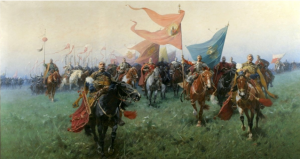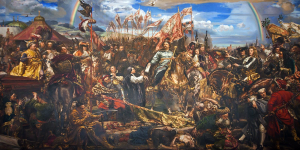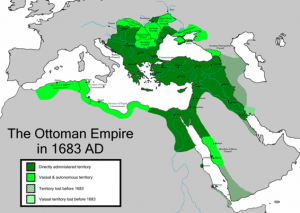Editor’s Note: the feast of the Holy Name of Mary occurs this Sunday, September 12th. This is the story of that feast.
The year is 1683. The Muhammadan empire have slowly rebuilt its forces since its defeat in 1571 at Lepanto. The news was spreading in Europe that the Turks had assembled a massive army to strike at the heart of Europe. In anticipation of an Ottoman invasion, Emperor Leopold I of Vienna in the Holy Roman Empire made a bilateral defense treaty with King Jan Sobieski III of the Polish-Lithuanian Commonwealth on March 31 1683, backed and guaranteed by Pope Innocent XI.
The unfolding of subsequent events is remembered and recalled with pride by the Poles and defenders of western civilization to this day. The consistent military successes of the outnumbered Polish Hussars against overwhelming odds is astounding, and many historians credit victory to military marvels. However, those that reduce the success of the battle of Vienna to military history grossly underestimate the forces at play in the battle which helped decide the fate of western civilization.
On July 14th, 1683, a force of 170,000 men, the main army of the Ottoman Empire led by Kara Mustafa arrived at the gates of Vienna and sent the traditional demand of surrender to the city. Only days ago a similar offer for surrender was accepted by a small town south of Vienna resulting in a mass slaughter of its inhabitants. Therefore, Vienna knew that surrender was not an option. The Ottoman sappers dug tunnels under the walls and packed them with gunpowder with the Viennese digging counter tunnels to sabotage their efforts in a siege that lasted for months.
Emperor Leopold I fled Vienna with his court westward and sent out messengers for immediate help to the rulers of Europe, one of which reached King Jan Sobieski III of Poland which read
We are not expecting your Majesty’s troops so much as your person, we are sure that your royal person at the head of our troops and your name, so dangerous to our common enemies, will ensure their defeat by themselves.
King Jan Sobieski was known as an exemplary military leader not only in Europe, but to the Ottomans as well. If going to war were only up to King Sobieski then he would leave immediately. However, even with the treaty, according to Polish law, the decision to fight a war in foreign territory was the jurisdiction of the parliament who, given a difficult financial situation and being involved in many recent conflicts was not enthusiastic about going to war.
The Marian monk and confessor of King Jan Sobieski, St. Stanislaus Papczyński (who earlier founded a Marian religious order) prayed all night with the Rosary in hands and begged the Blessed Virgin Mary for help who appeared to him with a message. At dawn, Papczyński rushed to tell the King the message he received from the Blessed Virgin.
“What did the Blessed Virgin say to you, Father? Speak!” The monarch was impatient. “I assure you, King, by the name of the Virgin Mary, that you will conquer and cover yourself, the Polish knighthood and your homeland with immortal glory!” Fr. Stanislaus said in a trembling voice.
Sobieski didn’t doubt the words of the Blessed Virgin as he had developed a devotion to her as a child. He grew up hearing about his great grandfather Stanisław Żółkiewski, who was a great military commander and wore a golden ring with the latin words Mancipium Mariae (Slave of Mary). Sobieski immediately ordered his entire court to be awakened and prepare for a military expedition. He asked Fr. Stanislaus to repeat his assurance about the victory of the Polish army at Vienna in the presence of the parliament and the papal messenger (Aleksandra Polewska, “Cud Pod Wiedniem, 1683”). With that, parliament gave their approval for war.
On July 18th, 1683, on the way to Krakow from Warsaw, in order to seek the help of the Queen of Heaven and Poland, Sobieski made a pilgrimage to the Jasna Góra Monestary in Częstochowa. Never before did Jasna Góra host the king and queen or such a large group of nobility as this year (Jana Związka, “Pielgrzymki Jana III Sobieskiego na Jasną Górę,” Studia Claromontana, [1983], 169-176). From the monastery he sent out 200 letters to military commanders throughout Poland for the immediate mobilization of all forces for war. Sobieski made a humble confession, prayed in front of the miraculous painting of Our Lady of Częstochowa, attended daily mass and received the Holy Eucharist. He also received from the hands of a Pauline monk the sword of the heroic military commander, his great grandfather, Stanisław Żółkiewski with the inscription “I am a slave of Mary.”
Sobieski departed Częstochowa to Krakow where soldiers and commanders from the entire nation were to gather. On his way, he stopped at various Marian sanctuaries to pray for divine assistance. Once in Krakow, Sobieski went to seven churches to pray for victory. On August 15th, the feast day of the Assumption of the Blessed Virgin Mary, King Jan Sobieski left Krakow to join with his army, which had departed earlier under two of his military commanders, leaving the entire nation virtually undefended. The entire Polish army and king passed through mountains, forests and crossed rivers, and headed towards Vienna to save the future of Christian Civilization.
On September 6th, Sobieski and his army crossed the Danube river at Tulln, 30km (20 miles) north of Vienna where the German and Austrian army gathered and were placed under his command. This brought the total troop numbers to 70,000-80,000 (including 30,000 of his own men) to face the remaining force of 150,000 Turks which lost 20,000 during the siege. On September 12th the day of the battle, King Jan Sobieski stood on the peak of the Kahlenberg mountains north of Vienna. Seeing the enemy for the first time, he noticed with his trained eye errors in their formations and took this as a first sign from God of impending victory. Before battle, the Holy Sacrifice of the Mass was said for Sobieski and the Polish nobility by Fr. Marco d’Aviano, the Apostolic messenger, and Sobieski entrusted himself and the whole army to the Blessed Mother.
After two months of siege by the Muhammadans, the situation around Vienna was dire. The Turks had taken all the surrounding villages and inside the city walls of Vienna, disease was rampant, stocks of food were dwindling, fatigue among soldiers was so great that any soldier found asleep on watch was ordered shot dead. The Ottoman sappers had already blown up massive portions of the wall and the Viennese, anticipating a breach were preparing for combat inside the city. The sappers were getting ready for a final detonation of ten more mines. This very moment was the peak of power for the Empire of Muhammad which was about to flood into Christendom for the first time since the invasion of Spain in 711.
Meanwhile, days before this, Sobieski had sent an express messenger back to Poland to deliver the word to his wife, Queen Maria Kazimiera, that his army was about to engage the enemy. This message reached the Queen on September 10th during her nightly prayers. So the Queen organised in Krakow a procession of the “spiritual army” with the Holy Eucharist, sung rosary, with the Queen, dressed in black, on September 12, the exact day of the battle. Throughout Krakow all fires were extinguished, and churches were packed with people praying the Rosary all day and fasting on bread and water for victory against the Muslim army (Fr. Józef Orchowski, Trypryk Różańcowy [Michalineum, 2001], 25-27).
The troops signaled their arrival to the Ottoman forces by setting bonfires on the mountain. Before the battle, Sobieski shouted:
Soldiers – not only Vienna must be saved! We must save all Christianity! Soldiers – we fight for Our Lady of Częstochowa, for the Black Madonna!
When the Turks noticed Sobieski’s army, they immediately attacked and the battle began at 4:00am. Sobieski fought the Turks and at the same time adjusted his forces to take back fortified villages in an attempt to reach the Vienna city walls and lift the siege. After eight hours of furious combat, Sobieski had taken key villages and was moving closer to striking at Vienna.
After two more hours of fighting, the army of Christendom was getting closer to rescuing their brethren behind the city walls and Sobieski shifted to attack the core strength of the Muhammadan army besieging Vienna. He moved his elite heavy cavalry unit into position. They were known as the Winged Hussars. As the cavalry neared their moment to charge they bellowed out the song “Bogurodzica” (“Mother of God” or “Theotokos” listen to it here).

It is recorded that after the infantry had captured most of the strategic positions, the elite Winged Hussars, all in a state of grace, slowly emerged from the edge of the Viennese forest at 4:00pm cheered by the onlooking allied infantry who were expecting them. They advanced forward, pressing the Turks as they approached the central position of the siege.
The Hussars regrouped and at 6:00pm King Sobieski ordered the final lethal blow and led the cavalry in charging the Turks himself. Three groups of Polish and one from the Holy Roman Empire equaled 18,000 heavy cavalry—it was the largest cavalry charge in recorded history. This charge first started slow to conserve the horses energy then gradually picked up to full gallop while simultaneously lowering the 6m (20ft) lance to a horizontal position towards the enemy as the hussar holding the lance level with all his strength, braced for impact. With the full momentum of a racing horse, an elite warrior and the grace of God behind the 6m spear, innumerable Turks were sent to be judged in the divine court by Jesus Christ, the One they rejected as God. The pain of the sentence issued was infinitely greater than the spear which sent them there and they would have rather relived that moment of mortal death perpetually for eternity than the spiritual death in the fire of the abyss.
The winged hussars charged down the hill and, as if by the hand of God, swept past the lines of the Ottoman army as their elite soldiers were decimated.
King Jan Sobieski and his winged hussars had won the battle and saved not only Vienna but Christian civilization from the rot of Islam. Due to diplomatic oversight, or perhaps with a deliberate decision, Sobieski triumphantly entered Vienna before the Holy Roman Emperor. The people kissed the hands, feet and garments of the king. The king took his first steps to the St. Stephen’s Cathedral, then to the Augustinians, where he laid a wreath in the chapel of Our Lady of Loreto, offered to him by the people of Vienna. After the Mass, the King with the army sang: Te Deum Laudamus.
Sobieski wrote a letter of victory to Pope Innocent XI with the famous words:
Venimus, vidimus, Deus vicit. (“We came, we saw, God conquered.”)
In a letter to his wife written the next day after the battle he wrote:
Ours are treasures unheard of… tents, sheep, cattle and no small number of camels… it is victory as nobody ever knew of, the enemy now completely ruined, everything lost for them. They must run for their sheer lives… Commander Starhemberg hugged and kissed me and called me his savior (my translation).
Pope Innocent XI, by the request of King Jan Sobieski, made September 12th a Feast of the Most Holy name of Mary to commemorate the victory that was done in Her name. (Pope Paul VI later abolished the feast in the Novus Ordo, but it was restored by Polish Pope John Paul II).
Kara Mustafa, upon returning to the Ottoman Empire, was sentenced to death on December 25th Christmas Day. As if by God’s providence, the death of the one who tried to destroy Christian Civilization happened on the day of the birth of the One on whom Christian Civilization was built and was now to continue.
Jesus is King, and Mary Ever-Virgin!

Photo of St. Stephen’s Cathedral in Vienna by Dimitry Anikin on Unsplash.
All other images via Wiki commons.



